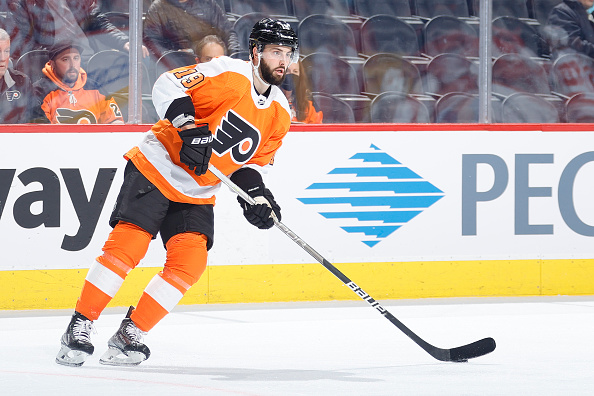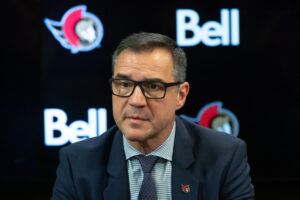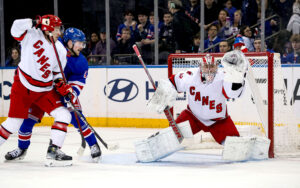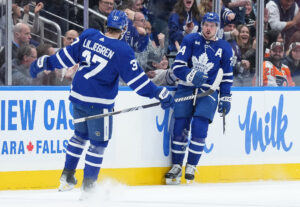Player development seems to always result in more questions than answers. How likely is it for a top pick to pan out? What makes a player a “steal”? Last Word On Hockey will be starting a new series on how to properly develop prospects from all different spots throughout the draft. This week’s piece involves top-10 picks and how they were used early in their careers.
Player Developments of Top-10 Picks
In the span of 2005 through 2015, there were 40 total selections made between fourth overall and tenth overall on forwards playing in North America. Of those 40 selections, five players were given patience in their player development. What that means is an extra year despite solid production that deemed them NHL-ready before being given a chance. Those five players were Nikolaj Ehlers, Mitch Marner, Sam Bennett, Jakub Voracek, and Derick Brassard. In this piece, we will be looking at Derick Brassard.
Player Development of Derick Brassard
Brassard, drafted sixth overall in the 2006 NHL draft by the Blue Jackets, has played over 900 NHL games in his career with nine different teams. It all started with the QMJHL’s Drummondville Voltigeurs in his DY-1 season. He scored 25 goals and 51 assists for 76 points in 69 games. That was good for a pace of 1.076 points per game, ranking 13th out of 40 forwards in DY-1 production. He followed that up with a fantastic season in his DY with Drummondville. Brassard scored 44 goals and 72 assists for 116 points in just 58 games. That was good for a pace of exactly two points per game, ranking tied for third among the 40 forwards in DY production.
However, that absurd season in the QMJHL was not enough to land him an opportunity in the NHL quite yet, getting sent back in his DY+1 season. Unfortunately, a very serious shoulder injury limited him to just 14 games that year, scoring six goals and 19 assists for 25 points in that limited time. That production was good for a pace of 1.786, ranking fifth among the 30 forwards not yet playing in the NHL in DY+1 production. Despite the limited playing time due to injuries, Brassard would turn pro the following season.
How was Brassard used?
In his first taste of NHL action, Brassard would play just 17 games, scoring a goal and an assist for two points, averaging just 9:03 time on ice per game. His advanced analytics were not good, with three of the four analytics looked at being below replacement level. Brassard’s EVD was the only above replacement stat, up at 0.1. His EVO (-0.4), WAR (-0.1) and GAR (-0.4) were slightly below replacement level and simply showed why Brassard was not given a longer look at the NHL level. Meanwhile, Brassard also played 42 AHL games that season, scoring 15 goals and 36 assists for 51 points, showing his offensive potential in a tough league.
As for his second season, Brassard would stick to the NHL roster and never see the AHL again. However, it still was not a season that ended well for Brassard. After scoring 10 goals and 15 assists for 25 points in 31 NHL games to start his official rookie season, Brassard would suffer another serious shoulder injury that required season-ending surgery. Despite the shortened season, Brassard would finish top-20 in Calder trophy voting, according to Elite Prospects. Up to that point in the season, Brassard had averaged 14:25 time-on-ice per game. His advanced analytics were a whole lot better. His EVO vastly improved (7.3) and his EVD steadily improved (2.2). As for his WAR and GAR, he recorded a very strong season by those metrics as well (2.1 and 11.4, respectively).
Brassard finally plays full NHL season
Finally, in his third NHL season, Brassard would play 79 games, averaging 14:57 time on ice per game. In that role, he scored nine goals and 27 assists for 36 points. His raw stats took a step back in terms of per-game rates (0.81 points per game in year two, down to 0.46 in year three), and that led to his analytics falling as well. For the first time, Brassard’s EVD dropped below replacement level (-3.6), while his EVO dropped a considerable amount (3.9). With his even-strength metrics falling the way they did, his WAR (0.3) and GAR (1.9) also took a major step back.
Brassard’s carousel of a career
Following those first three years, Brassard would play two and a half more years with Columbus. He totalled 182 games, scoring 38 goals and 68 assists for 106 points there. Then, he was traded to the New York Rangers in that last half-season he played with Columbus (2012-13) where he played 254 games, scoring 69 goals and 105 assists for 174 points. In 2016-17, he joined the Ottawa Senators, where he played 139 games, scoring 32 goals and 45 assists for 77 points, before being dealt to the Pittsburgh Penguins.
[pickup_prop id=”9767″]
With the Penguins, he would play 54 games with 12 goals and 11 assists for 23 points. That was before getting dealt to the Panthers. He would play just 10 games, scoring four total points, before being traded a second time. That happened in 2018-19, and he was sent to the Colorado Avalanche. With Colorado, he played just 20 games, with four goals. Brassard would then join the New York Islanders the following season. There, he scored 10 goals and 22 assists for 32 points in 66 games. Following that season, he would join the Arizona Coyotes for 53 games. He would score eight goals and 12 assists for 20 points. This season, playing for the Flyers, Brassard has scored four goals and seven assists for 11 points. That’s across 22 games so far.
Brassard’s player development went… okay?
Brassard’s first three seasons certainly weren’t bad, and his production was fairly consistent in his time with Columbus. Despite all the movement from team to team throughout his career, Brassard has remained fairly consistent. He has maintained himself as a solid middle-six forward everywhere he has gone. Averaging over 15 minutes of ice time between his fourth season and his 12th season. In his last three seasons, he has averaged 14:07 per game. Had he not been constantly moved around, there’s a chance his player development would have progressed better than it had.
Junior league stats via Elite Prospects, NHL stats via Hockey Reference, NHL analytics via Evolving Hockey
Main photo:
Embed from Getty Images






